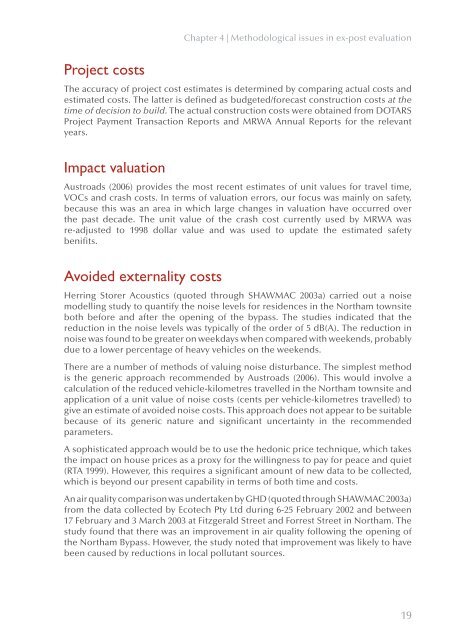PDF: 667 KB - Bureau of Infrastructure, Transport and Regional ...
PDF: 667 KB - Bureau of Infrastructure, Transport and Regional ...
PDF: 667 KB - Bureau of Infrastructure, Transport and Regional ...
Create successful ePaper yourself
Turn your PDF publications into a flip-book with our unique Google optimized e-Paper software.
Chapter 4 | Methodological issues in ex-post evaluation<br />
Project costs<br />
The accuracy <strong>of</strong> project cost estimates is determined by comparing actual costs <strong>and</strong><br />
estimated costs. The latter is defined as budgeted/forecast construction costs at the<br />
time <strong>of</strong> decision to build. The actual construction costs were obtained from DOTARS<br />
Project Payment Transaction Reports <strong>and</strong> MRWA Annual Reports for the relevant<br />
years.<br />
Impact valuation<br />
Austroads (2006) provides the most recent estimates <strong>of</strong> unit values for travel time,<br />
VOCs <strong>and</strong> crash costs. In terms <strong>of</strong> valuation errors, our focus was mainly on safety,<br />
because this was an area in which large changes in valuation have occurred over<br />
the past decade. The unit value <strong>of</strong> the crash cost currently used by MRWA was<br />
re-adjusted to 1998 dollar value <strong>and</strong> was used to update the estimated safety<br />
benifits.<br />
Avoided externality costs<br />
Herring Storer Acoustics (quoted through SHAWMAC 2003a) carried out a noise<br />
modelling study to quantify the noise levels for residences in the Northam townsite<br />
both before <strong>and</strong> after the opening <strong>of</strong> the bypass. The studies indicated that the<br />
reduction in the noise levels was typically <strong>of</strong> the order <strong>of</strong> 5 dB(A). The reduction in<br />
noise was found to be greater on weekdays when compared with weekends, probably<br />
due to a lower percentage <strong>of</strong> heavy vehicles on the weekends.<br />
There are a number <strong>of</strong> methods <strong>of</strong> valuing noise disturbance. The simplest method<br />
is the generic approach recommended by Austroads (2006). This would involve a<br />
calculation <strong>of</strong> the reduced vehicle-kilometres travelled in the Northam townsite <strong>and</strong><br />
application <strong>of</strong> a unit value <strong>of</strong> noise costs (cents per vehicle-kilometres travelled) to<br />
give an estimate <strong>of</strong> avoided noise costs. This approach does not appear to be suitable<br />
because <strong>of</strong> its generic nature <strong>and</strong> significant uncertainty in the recommended<br />
parameters.<br />
A sophisticated approach would be to use the hedonic price technique, which takes<br />
the impact on house prices as a proxy for the willingness to pay for peace <strong>and</strong> quiet<br />
(RTA 1999). However, this requires a significant amount <strong>of</strong> new data to be collected,<br />
which is beyond our present capability in terms <strong>of</strong> both time <strong>and</strong> costs.<br />
An air quality comparison was undertaken by GHD (quoted through SHAWMAC 2003a)<br />
from the data collected by Ecotech Pty Ltd during 6-25 February 2002 <strong>and</strong> between<br />
17 February <strong>and</strong> 3 March 2003 at Fitzgerald Street <strong>and</strong> Forrest Street in Northam. The<br />
study found that there was an improvement in air quality following the opening <strong>of</strong><br />
the Northam Bypass. However, the study noted that improvement was likely to have<br />
been caused by reductions in local pollutant sources.<br />
19

















